old Ladybird Books
Please note site is in retirement. It's now found here ladybirdflyawayhome.com
Sunday 2 August 2020
Friday 2 November 2018
My top-10 of Ladybird trivia
PLEASE NOTE - this blog has now moved to:
My top-10 of Ladybird book trivia
Or 'ten things you have probably never wanted to know about Ladybird books'
10
The price of a Ladybird book (2 shillings and 6) stayed the same for 31 years -from 1940 until 1971 (decimilisation).
Over those thirty-one years, the increased book sales and lower production costs allowed the company to fulfill its commitment to produce good quality and affordable books. Even at the time of decimilisation, the director's strove to maintain the relative price of the books - but in the face of post-decimilisation inflation, they were forced to concede defeat. (The one positive side of this for collectors is that the price stamped on the back of many Ladybird books after 1970 helps identify the age of the book where other clues are lacking).
9
The artist Frank Humphris was an honorary member of a native American tribe and was also temporary deputy sheriff of Bexar County, Texas.
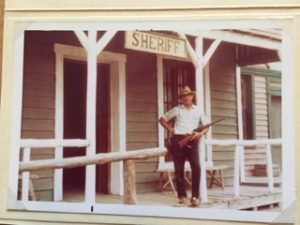
It was his passion for all things to do with 'The Wild West', led Douglas Keen to create a series of books for him: series 707. He illustrated them all and also wrote the books 'Cowboys', 'Indians of the Western Plains' and ''Battle of the Little Big Horn'. Humphris' fascination for the subject earned him the nickname 'fast draw'. He was another of the artists who came to Ladybird after working on the Eagle comic, where his work included another western-themed comic strip 'Riders of the Range', which he drew until 1962. Perhaps because they both worked for Eagle before Ladybird, Frank Humphris is sometimes confused with Frank Hampson.

8
Writer Noel Barr was a woman.
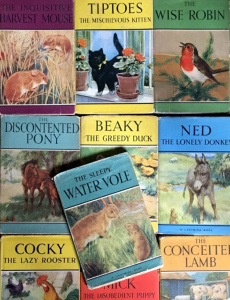
Noel Barr wrote the ever popular Animal Tales such as 'Mick the Disobedient Puppy', 'The Wise Robin', 'Beaky the Greedy Duck', 'Ned the Lonely Donkey' and 'Tiptoes the Mischievous Kitten'. Perhaps not surprisingly, commentators all too often refer to Barr with the pronoun 'he'.
7
Producing a Ladybird book was often a family affair.

There are various examples of husband's illustrating books which had been written or conceived by their wives. Family members were also often drafted in to act as models for the illustrations. A case in point is the book 'The Story of Metals' which was written by the father, Lesley Aitchison, illustrated by son, Martin Aitchison, and modelled for by grandson Nick.
6
After the WW2, Ladybird came close to stopping children's book publication for good - intending that their post-war core business would again be commercial printing.
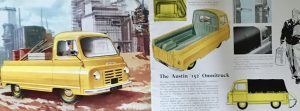 Wills & Hepworth car brochure[/caption]
Wills & Hepworth car brochure[/caption]Douglas Keen, the visionary employee who steered Ladybird to phenomenal success, was advised to concentrate on Motor Trade publishing when he returned to the company after war service because the directors saw no future in children's publishing.
Fortunately, he didn't heed the advice, but instead set to work to convince the board that this was the area of the company to develop. His efforts finally bore fruit in the early 1950s. Today most people would be unaware that the company behind Ladybird ever printed anything else.
5
Ladybird Books' commissioning editor Douglas Keen considered himself to be a Marxist.

Although commercial considerations always had to come first, Keen's beliefs shine through nonetheless, for example in the emphasis placed on public services, especially free education, libraries and healthcare.
4
Five different artists illustrated, and reillustrated, the Peter and Jane key word reader series over a period of 14 years.
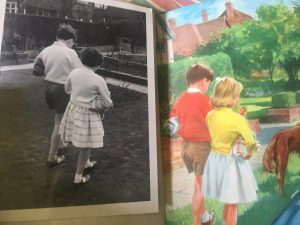
They each used different models so there are lots of different 'real Peter and Janes' walking around today.
3
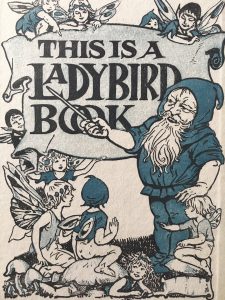 The Ladybird logo feels timeless - but the brand had no logo at all for the first 27 years of publishing.
The Ladybird logo feels timeless - but the brand had no logo at all for the first 27 years of publishing.

Even when the first logo was devised (1941) it depicted a rather indistinctive ladybird in flight.
2
Ladybird artist Martin Aitchison, who illustrated many of the Peter and Jane books, had worked with Barnes Wallis, producing illustrations to help Wallis 'sell' his idea of a bouncing bomb.

Aitchison's deafness barred him from active service but his war work was for Vickers Aircraft. Aitchison's father had been a friend of Wallis from university days.
1
Until the 21st century, not one Ladybird book was ever branded 'For boys' or 'For girls'.

This was an important tenet of the company over the Douglas Keen years. Nor were colours used to guide boys or girls more indirectly towards particular choices; in most cases the choice of book spine colour appears to have been a random one.
(For more of such fun-facts, see ladybirdflyawayhome.com)
Monday 15 October 2018
An afternoon with John Kenney
 |
| Artwork from Robin Hood book The Silver Arrow. (Captain Scott is just for scale!) |
PLEASE NOTE - this blog has now moved to:
Last week I spent an afternoon surrounded by the artwork of the Ladybird artist John Kenney. I went to The MERL (Museum of English Rural Life) in Reading where the Special Collections are stored. I've talked about MERL and the Ladybird room before on this blog but this time I went to see some of the original artwork of John Kenney which is not normally on display.
Although the majority of the original Ladybird artwork housed in the Reading University special collection is relatively modern (from the 1980s onwards) there are some wonderful sets, or part-sets, of artwork by some of the best-loved artists stored there. But space is very limited and so very little is on display at any one time.
Ladybird artist John Kenney died in 1972 so, of course, I never had a chance to meet him. But I have been friends with his family ever since I appeared on the Antiques Roadshow many moons ago. They live in Leicestershire so we don't often get a chance to meet. But Clare, from the Univeristy of Reading Art Collections, invited the family to Reading to view the Kenney artwork stored there - and I was allowed to tag along.
John Kenney must have illustrated around 30 books for Ladybird and some or all of the artwork from around 17 of these books is kept at Reading. I myself have the artwork for one further Kenney Ladybird book - but it's a bit of a mystery what happened to the rest.
Clare had been very busy before we arrived, spreading the boxes of artwork out on a large table so we could peruse it in comfort. Now you may wonder why it is that someone as familiar with the Ladybird illustrations as I am should take so much pleasure in this.
But the fact is that the original Ladybird artwork is always a treat to behold; the colours so much more vivid and the artistry so more more apparent. In the case of the Kenney artwork, the scale of some of the pieces was a revelation. Kenney mainly earned his crust as a painter of hunting scenes in the Leicestershire area and when he began his first commission for Ladybird (King Alfred the Great) he seems to have taken one of his pre-existing canvases, rotated it from landscape to portrait and made a start.
I don't think original Ladybird artwork can ever have been produced on a larger scale. This picture should give you an idea of the relative size to the completed book.
Tootles the Taxi is one of the best loved of all Ladybird books from the 1950s and 60s. Again the artwork is by Kenney, who also illustrated some of the original 'Thomas the Tank Engine' Railway series books for the Reverend Awdry. The similarities to the Railway Series books is clear. In addition, the story goes that Kenney based his Tootles characters on Dinky toys.
The artist John Kenney's family had previously shown me a charming couple of illustrations that he had Kenney produced as preparation for the Tootles commission. What made my visit to Reading unique on this occasion was that I was able to see the early preparatory painting alongside the final original artwork. Fear not: I took a photo so you can see them too.
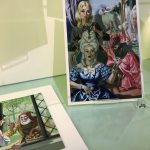 |
| This artwork was on display in the Ladybird room. Not, of course, by John Kenney but by Eric Winter |
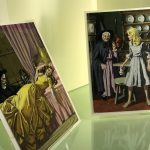 |
| Eric Winter original artwork |
Although the majority of the original Ladybird artwork housed in the Reading University special collection is relatively modern (from the 1980s onwards) there are some wonderful sets, or part-sets, of artwork by some of the best-loved artists stored there. But space is very limited and so very little is on display at any one time.
Ladybird artist John Kenney died in 1972 so, of course, I never had a chance to meet him. But I have been friends with his family ever since I appeared on the Antiques Roadshow many moons ago. They live in Leicestershire so we don't often get a chance to meet. But Clare, from the Univeristy of Reading Art Collections, invited the family to Reading to view the Kenney artwork stored there - and I was allowed to tag along.
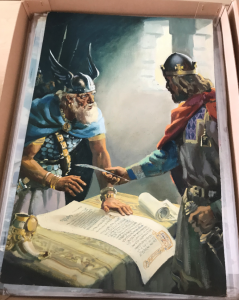 |
| The cover artwork for Alfred The Great |
John Kenney must have illustrated around 30 books for Ladybird and some or all of the artwork from around 17 of these books is kept at Reading. I myself have the artwork for one further Kenney Ladybird book - but it's a bit of a mystery what happened to the rest.
 |
| Cover artwork for Queen Elizabeth and the Tilbury Speech |
Clare had been very busy before we arrived, spreading the boxes of artwork out on a large table so we could peruse it in comfort. Now you may wonder why it is that someone as familiar with the Ladybird illustrations as I am should take so much pleasure in this.
 |
| Artwork from The First Queen Elizabeth. (Florence is there just for scale) |
But the fact is that the original Ladybird artwork is always a treat to behold; the colours so much more vivid and the artistry so more more apparent. In the case of the Kenney artwork, the scale of some of the pieces was a revelation. Kenney mainly earned his crust as a painter of hunting scenes in the Leicestershire area and when he began his first commission for Ladybird (King Alfred the Great) he seems to have taken one of his pre-existing canvases, rotated it from landscape to portrait and made a start.
 |
| The book David Livingstone shows the large scale of the artwork |
I don't think original Ladybird artwork can ever have been produced on a larger scale. This picture should give you an idea of the relative size to the completed book.
 |
| Cover art for Tootles the Taxi |
The artist John Kenney's family had previously shown me a charming couple of illustrations that he had Kenney produced as preparation for the Tootles commission. What made my visit to Reading unique on this occasion was that I was able to see the early preparatory painting alongside the final original artwork. Fear not: I took a photo so you can see them too.
 |
| Tootles the Taxi: the book, the artwork and the prototype (For lots more about vintage Ladybird books, head to ladybirdflyawayhome.com |
Sunday 14 October 2018
I learnt about flowers from Ladybird books
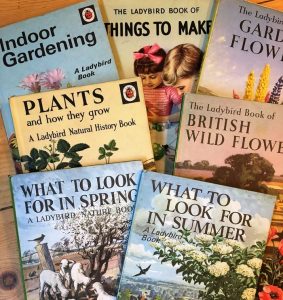
PLEASE NOTE - this blog has now moved to:
Flowers didn’t feature much in my childhood. Our garden was tiny, my parents both worked and money was rather tight. We lived in a street of terraced houses, surrounded by similar streets – a perfectly pleasant environment in many ways – but floral decoration was sparse.
But that’s not the whole story. Both my parents were teachers and my house was filled with books: many of them Ladybird Books. The imagery of my childhood is a strange collage of reality and book artwork. Even before I could read, I was reading the pictures of the books that surrounded me and these pictures were beautiful. I learnt about flowers from Ladybird Books.


First there were garden flowers. In my Ladybird Book of Garden Flowers, gardens were a remote and alien place –striking and colourful but as far away from my life as Never Never Land. The vibrant colours of the plants contrasted with the grey splendour of the buildings in the background.
The sky was often dark and stormy: it was the flowers that brought the optimism to the picture. Life was calm and stately and ordered. Nature, with its stormy skies, might threaten change, but as long as the gardener was in charge all would be managed and all would be well.
Then there was the Ladybird Book of Wild Flowers and here the scenes were very different. Human activity was barely visible or was shown in decay: a ruined monastery, a broken bridge.



The flowers were less bright and showy and had to battle harder on the page to gain my attention. The colours were more muted: lots of blues, palest pink with splashes of yellow. I wasn’t sure what I thought of wild flowers.
Both books were produced by Ladybird with the idea that they would be simple field guides, to be used by the curious child for reference and to stimulate their curiosity. On the left-hand side of every page was the name and description of the plants pictured. I’m sure lots of children used them in this way, but I don’t think I ever did. For me, the attraction was pouring over the details in the background. Who was in that carriage, coming up the drive. What was through that arch? Why was the bridge falling down?
Then there was Indoor Gardening – a whole book dedicated to telling children like me that I too could be a gardener – as long as I had a window sill and an odd collection of containers: glass bottles, chipped pottery or an old teapot.
]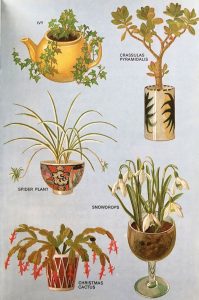
But this looked too much like a school project to me – as did the helpful diagrams in Plants and How they Grow. I did have a go at making the ‘Minature Garden’ in The Ladybird Book of Things to Make – but like all the projects in that book, when I’d finished it didn’t look anything like the picture.
Finally there was the magic of picking wild flowers. Yes, I know – and you must remember this, children – that we don’t pick wild flowers today. But in 1960s Ladybird Land it was fine to pick wild flowers. Goldilocks was filling her basket with bluebells when she discovered the Three Bears’ House. Little Red Riding Hood gathered an amazingly varied woodland bouquet to take to her grandmother.
Picking wildflowers was almost an emblem of childhood and freedom – a prelude to adventure and enjoyed equally by boys and girls. The sky was blue, there were no adults in sight, clothes never got dirty: and we never saw the miserable picked flowers in their vases and jam jars, wilting and withering only hours later.
That just didn’t happen in Ladybird Land.
I grew up and Ladybird Books grew up – and, for a time, I fared better than they did. I had a house with a garden and started to enjoy walks in the country and visits to garden-centres. Ladybird struggled with ever-increasing competition in the book market and, in the 1980s, swapped expertly-crafted artwork for much cheaper photography.
Looking back, I realise I did everything backwards. The books I grew up with were intended to help children identify the plants they saw around them. I don’t remember seeing plants around me when I was growing up, but later found myself identifying well-remembered Ladybird imagery in the landscapes of my adult life.
Perhaps on a walk in the country I’ll turn a corner and be confronted with a scene that transports me straight back to a page in What to Look for in Spring or Wild Flowers.
The pictures came first, and the plants came second. But one way or another the books of my childhood taught me to enjoy and to appreciate flowers, and in the end I don’t suppose it matters which way round it happens.
But that’s not the whole story. Both my parents were teachers and my house was filled with books: many of them Ladybird Books. The imagery of my childhood is a strange collage of reality and book artwork. Even before I could read, I was reading the pictures of the books that surrounded me and these pictures were beautiful. I learnt about flowers from Ladybird Books.


First there were garden flowers. In my Ladybird Book of Garden Flowers, gardens were a remote and alien place –striking and colourful but as far away from my life as Never Never Land. The vibrant colours of the plants contrasted with the grey splendour of the buildings in the background.
The sky was often dark and stormy: it was the flowers that brought the optimism to the picture. Life was calm and stately and ordered. Nature, with its stormy skies, might threaten change, but as long as the gardener was in charge all would be managed and all would be well.
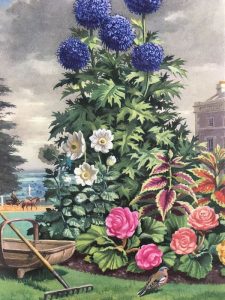 |
| Three John Leigh-Pemberton illustrations from ‘Garden Flowers |
Then there was the Ladybird Book of Wild Flowers and here the scenes were very different. Human activity was barely visible or was shown in decay: a ruined monastery, a broken bridge.



The flowers were less bright and showy and had to battle harder on the page to gain my attention. The colours were more muted: lots of blues, palest pink with splashes of yellow. I wasn’t sure what I thought of wild flowers.
Both books were produced by Ladybird with the idea that they would be simple field guides, to be used by the curious child for reference and to stimulate their curiosity. On the left-hand side of every page was the name and description of the plants pictured. I’m sure lots of children used them in this way, but I don’t think I ever did. For me, the attraction was pouring over the details in the background. Who was in that carriage, coming up the drive. What was through that arch? Why was the bridge falling down?
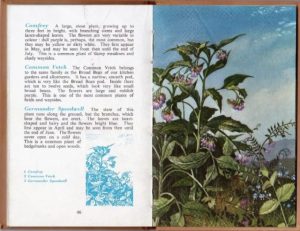 |
| ‘British Wild Flowers’ illus. Rowland and Edith Hilder |
]

 |
| ‘Indoor Gardening’ illus. BH Robinson |
 |
| ‘Things to Make’, illus. G Robinson |
Finally there was the magic of picking wild flowers. Yes, I know – and you must remember this, children – that we don’t pick wild flowers today. But in 1960s Ladybird Land it was fine to pick wild flowers. Goldilocks was filling her basket with bluebells when she discovered the Three Bears’ House. Little Red Riding Hood gathered an amazingly varied woodland bouquet to take to her grandmother.
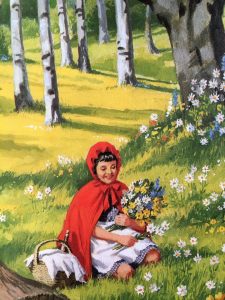 |
| ‘Little Red Riding Hood’, illus. Eric Winter |
 |
| ‘Goldilocks’, illus. Harry Wingfield |
That just didn’t happen in Ladybird Land.
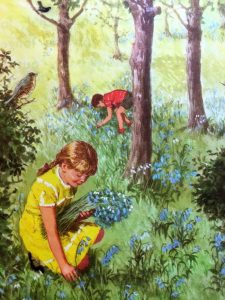 |
 |
| ‘Prayers through the Year’, illus. Clive Uptton. ‘The Lord’s Prayer’, illus. Harry Wingfield |
I grew up and Ladybird Books grew up – and, for a time, I fared better than they did. I had a house with a garden and started to enjoy walks in the country and visits to garden-centres. Ladybird struggled with ever-increasing competition in the book market and, in the 1980s, swapped expertly-crafted artwork for much cheaper photography.
Looking back, I realise I did everything backwards. The books I grew up with were intended to help children identify the plants they saw around them. I don’t remember seeing plants around me when I was growing up, but later found myself identifying well-remembered Ladybird imagery in the landscapes of my adult life.
Perhaps on a walk in the country I’ll turn a corner and be confronted with a scene that transports me straight back to a page in What to Look for in Spring or Wild Flowers.
The pictures came first, and the plants came second. But one way or another the books of my childhood taught me to enjoy and to appreciate flowers, and in the end I don’t suppose it matters which way round it happens.
(This post was first published on Freddie's Flowers blog) Learn more about vintage Ladybird books at Ladybirdflyawayhome.com
Wednesday 10 October 2018
So what's the story? The prototype Ladybird book
So many of us will have grown up with Ladybird books at school in the 1960s and 70s that it's hard to remember that they weren't always a fixture on school shelves. The school market certainly wasn't in the minds of the company when the Loughborough printers, called Wills & Hepworth, first began publishing children's books. The first classic Ladybird books, which came out in the 1940s, were fiction and designed for pre-school children, with rhymes about animals, Nursery Rhymes, ABC picture books and re-tellings of traditional tales such as Dick Whittington.
What's more, in the 1940s, publishing children's books was seen as a sideline to the core business of Wills & Hepworth, who focused on local commercial printing, among a diverse range of other activites. There was even some talk in the late 1940s of ceasing children's book publication altogether, to concentrate on printing for the burgeoning Midlands car business. Yet within 15 years, everything had changed. Ladybird was firmly established as one of the biggest players in children's publishing and the books could be found in almost every school and library and a great many homes as well. So what was it that led to this abrupt change in direction and in fortunes?
On his return to Wills & Hepworth after his war service, employee Douglas Keen was given the minor area of 'Ladybird books' to look after.
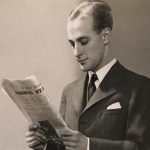
Travelling the country as a salesman and speaking to many different wholesale book-buyers, Keen realised there was a gap in the book market for well-made, robust and colourful books in schools. He felt the Ladybird format could meet this market well and tried to convince the board that they should increase the age-range of publications and focus on non-fiction. But his ideas fell on deaf ears. Children's book publishing was still seen as a sideshow, Keen as enthusiastic but misguided, and the company went on as before. Keen persisted - motivated not only by his vision and belief in the importance of good educational materials for all, but by the pragmatic requirement to secure and further his career.

He chose a topic that interested him - British Birds - and wrote the sort of book he had in mind, with each page devoted to a different bird.
His mother-in-law, Margaret Jones, was a talented amateur water-colour artist and she created the plates for the facing page. His wife, also Margaret, shared the artistic talent and she created the small vignettes for the text page using ink and scraper-board. This book was much larger than a standard-sized Ladybird so a separate version was produced in the the classic small size.


The resulting book was shown to the board - and this time it convinced them. British Birds and Their Nests was commissioned, written by Vesey-Fitzgerald and illustrated by Allen Seaby. It was a huge success. More nature books and non-fiction books swiftly followed. Ladybird's commercial success began to take off in spectacular fashion. Quickly other aspects to the business were dropped and Keen's own star also rose sharply. He was soon appointed to the board and within a short time was responsible for commissioning all titles from then until the sale of the company at his retirement in the mid-1970s.
So an inconspicuous item at first glance - but with quite a story to tell.


 |
| The large prototype book, with overlay down over Margaret's illustration. Also the small prototype and the final book |
What's more, in the 1940s, publishing children's books was seen as a sideline to the core business of Wills & Hepworth, who focused on local commercial printing, among a diverse range of other activites. There was even some talk in the late 1940s of ceasing children's book publication altogether, to concentrate on printing for the burgeoning Midlands car business. Yet within 15 years, everything had changed. Ladybird was firmly established as one of the biggest players in children's publishing and the books could be found in almost every school and library and a great many homes as well. So what was it that led to this abrupt change in direction and in fortunes?
On his return to Wills & Hepworth after his war service, employee Douglas Keen was given the minor area of 'Ladybird books' to look after.

Travelling the country as a salesman and speaking to many different wholesale book-buyers, Keen realised there was a gap in the book market for well-made, robust and colourful books in schools. He felt the Ladybird format could meet this market well and tried to convince the board that they should increase the age-range of publications and focus on non-fiction. But his ideas fell on deaf ears. Children's book publishing was still seen as a sideshow, Keen as enthusiastic but misguided, and the company went on as before. Keen persisted - motivated not only by his vision and belief in the importance of good educational materials for all, but by the pragmatic requirement to secure and further his career.
 |
Keen wrote the text, his mother-in-law produced the illustrations and his wife produced the vignettes
|

He chose a topic that interested him - British Birds - and wrote the sort of book he had in mind, with each page devoted to a different bird.
His mother-in-law, Margaret Jones, was a talented amateur water-colour artist and she created the plates for the facing page. His wife, also Margaret, shared the artistic talent and she created the small vignettes for the text page using ink and scraper-board. This book was much larger than a standard-sized Ladybird so a separate version was produced in the the classic small size.


The resulting book was shown to the board - and this time it convinced them. British Birds and Their Nests was commissioned, written by Vesey-Fitzgerald and illustrated by Allen Seaby. It was a huge success. More nature books and non-fiction books swiftly followed. Ladybird's commercial success began to take off in spectacular fashion. Quickly other aspects to the business were dropped and Keen's own star also rose sharply. He was soon appointed to the board and within a short time was responsible for commissioning all titles from then until the sale of the company at his retirement in the mid-1970s.
So an inconspicuous item at first glance - but with quite a story to tell.


Thursday 3 May 2018
A new Home for Ladybird Fly Away
I've decided to move my blog and to merge it with my website to make everything easier to maintain.
You should find all the old content still - but you'll find it here:
http://ladybirdflyawayhome.com/
Hope you enjoy the new look
Monday 16 April 2018
The Ladybird Artists - 1940 to 1975
Here are more details about the Ladybird Artists exhibition, which will be taking place in Canterbury over the summer months (2018).
It will be held at The Beaney House of Art and Knowledge, in the centre of Canterbury.
Entry is free: it's a council-run gallery. Here it is one their website:
https://canterburymuseums.co.uk/events/the-story-of-the-ladybird-artists-1940-75/
It opens on 9th June and will run until 22nd of September so will be the main annual exhibition.
What will be covered:
A brief intro to the background of the company but then a longer look at a number of the artists whose amazing artwork was such a big part of Ladybird's success, focusing on the years between 1940 and 1975 - just after the sale of the company.
I'll be showing lots of original artwork - much from Ladybird books but also a look at the other work that these artists produced. There will, of course, be masses of books (many which you can browse through) and ephemera and some of the hundreds of quirky bits of information that I've picked up over the years.
95% of the exhibition will be from my own collection, which I've never exhibited before. Some of the artists' families have also kindly loaned me some lovely items, to help bring the exhibition to life.
So I really hope you can make it.
Subscribe to:
Posts (Atom)


